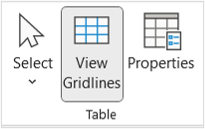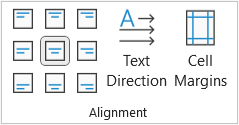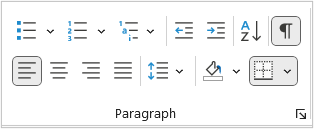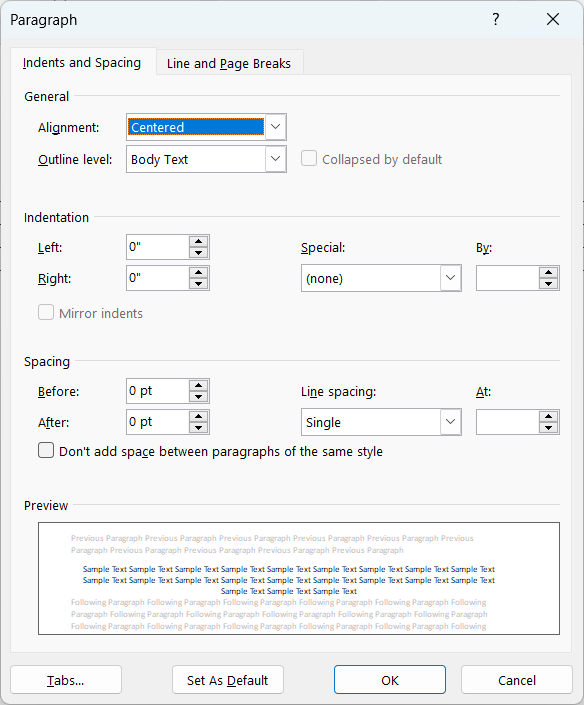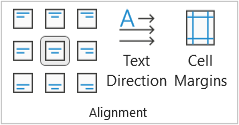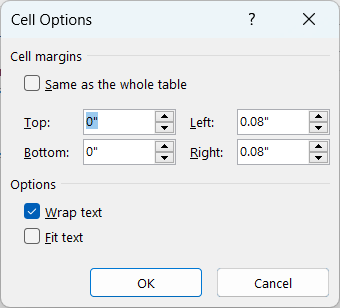Center or Align Text Vertically in Word Table Cells
by Avantix Learning Team | Updated June 15, 2023
Applies to: Microsoft® Word® 2016, 2019, 2021 and 365 (Windows)
You can center or align text vertically in cells in a Word table using commands in the Table Design or Table Tools Design tab in the Ribbon. If the text doesn't seem to align correctly, there are several common issues that may be affecting the alignment including extra blank paragraphs, paragraph spacing and cell margins.
Note: Buttons and Ribbon tabs may display in a different way (with or without text) depending on your version of Word, the size of your screen and your Control Panel settings. For newer versions of Word, Ribbon tabs may appear with different names. For example, the Table Tools Design tab may appear as Table Design.
Recommended article: 10 Microsoft Word Shortcuts for Moving Around in Tables
Do you want to learn more about Microsoft Word? Check out our virtual classroom or in-person classroom Word courses >
Display gridlines
When you are working with tables, it's a good idea to turn gridlines on. Borders, which are a format, will print. Gridlines do not print.
To display gridlines in Word:
- Click in a table.
- Click the Table Layout or Table Tools Layout tab in the Ribbon.
- Click View Gridlines in the Table group. Gridlines will stay on for all Word documents.
View Gridlines appears on the Table Layout or Table Tools Layout tab when you click in a table:
Center or align text vertically in table cells using the Ribbon
To center or align text vertically in table cells:
- Select the cells with the text that you want to center or align vertically.
- Click the Table Layout or Table Tools Layout tab in the Ribbon.
- In the Alignment group, click one of the vertical alignment options.
You can click the following alignment options in the Alignment group to apply vertical alignment:
- Align Center Left (centers the text vertically and aligns on the left horizontally)
- Align Center (centers the text vertically and horizontally)
- Align Center Right (centers the text vertically and aligns on the right horizontally)
The Alignment commands appear in the Alignment group in the Table Layout or Table Tools Layout tab in the Ribbon:
Center or align text vertically in table cells using Table Properties
To center or align text vertically in table cells using Word's Table Properties:
- Select the cells with the text that you want to center or align vertically.
- Right-click and select Table Properties from the drop-down menu. A dialog box appears.
- Click the Cell tab.
- Click Top, Bottom or Center.
- Click OK.
Solution: Vertical alignment issue #1 – extra blank paragraphs
If the text does not appear to center vertically, a common issue is unnecessary blank paragraphs (extra returns).
To view and remove extra blank paragraphs in a table:
- Click the Home tab in the Ribbon.
- In the Paragraph group, click Show / Hide Paragraph Marks to display paragraph marks and other non-printing characters.
- In the table, select the first unnecessary paragraph and press Delete. Repeat for other unnecessary paragraphs.
Show / Hide Paragraph Marks appears in the Paragraph group in the Home tab in the Ribbon:
Solution: Vertical alignment issue #2 – paragraph spacing
If a user has manually changed line spacing or changed paragraph spacing in the Normal style (which is used by default as the base style for tables), this can result in issues with vertical alignment in a table.
To change line spacing in a table:
- Select the table (click the four cornered arrow on the top left of the table or drag over all of the cells in the table).
- Click the Home tab in the Ribbon.
- Click the dialog box launcher on the bottom right corner of the Paragraph group. The Paragraph dialog box appears.
- In the Spacing area, change the Space Before and After to 0 and Line Spacing to Single. You also have the option of entering other amounts for Space Before and After (such as 8 Before and 6 After.) This can then give the appearance of centering vertically even if the vertical alignment is set to top.
- Click OK.
The Paragraph dialog box appears as follows:
By default, Word bases table styles on the Normal style. Currently, In Word 2016 and later versions, the default Normal style is set to 1.08 Line spacing (in inches if you are working in inches) with a Space After of 8 points. When you create a table and apply a table style, Word changes the Line spacing to single and the Space Before and After to 0. In this case, vertical alignment should work correctly. However, if you change the Normal style's Line spacing or Space Before and / or After settings, vertical alignment would be affected by the paragraph spacing changes and text may not appear to align vertically as expected.
Because of this issue (and for other reasons relating to the "Based on" concept), it's best to change only the font and size in the Normal style and use another style such as Body Text to apply paragraph spacing to body paragraphs. Ideally, the font should be changed by changing the Font Theme.
Solution: Vertical alignment issue #3 – cell margins
Another less common issue is cell margins. If cell margins have been changed, text may not appear to center or align vertically as expected.
To change cell margins for a table:
- Click in the table.
- Select the Table Layout or Table Tools Layout tab in the Ribbon.
- In the Alignment group, click Cell Margins. A dialog box appears.
- Enter the desired margins for Top and Bottom (enter 0 or the same amount for both).
- Click OK. All cells in the table will be affected.
Cell Margins appears in the Alignment group in the Table Layout or Table Tools Layout tab in the Ribbon:
To change cell margins for specific cells in a table:
- Select the cells with the margins you want to change.
- Right-click in the table and select Table Properties from the drop-down menu. A dialog box appears.
- Click the Cell tab.
- Click Options. A dialog box appears.
- Enter the desired margins for Top and Bottom (enter 0 or the same amount for both).
- Uncheck or de-select Same as whole table.
- Click OK twice.
The Cell Options dialog box appears as follows:
You may want to consider creating or modifying a table style to apply table formatting.
To learn more about working with table styles, check out the article How to Format Microsoft Word Tables Using Table Styles (Ultimate Guide).
If you are still not able to align text vertically in a table, you may have merged cells and you may need to unmerge them.
Subscribe to get more articles like this one
Did you find this article helpful? If you would like to receive new articles, JOIN our email list.
More resources
4 Ways to Delete a Table in Word
How to Center Text Vertically on a Page in Word
How to Insert Formulas and Functions in Word Tables
How to Keep a Microsoft Word Table Together on One Page
How to Delete a Page in Word (Remove Blank or Extra Pages)
Related courses
Microsoft Word: Intermediate / Advanced
Microsoft Excel: Intermediate / Advanced
Microsoft PowerPoint: Intermediate / Advanced
Microsoft Word: Long Documents Master Class
Microsoft Word: Styles, Templates and Tables of Contents
Microsoft Word: Designing Dynamic Word Documents Using Fields
Our instructor-led courses are delivered in virtual classroom format or at our downtown Toronto location at 18 King Street East, Suite 1400, Toronto, Ontario, Canada (some in-person classroom courses may also be delivered at an alternate downtown Toronto location). Contact us at info@avantixlearning.ca if you'd like to arrange custom instructor-led virtual classroom or onsite training on a date that's convenient for you.
Copyright 2024 Avantix® Learning
You may also like
How to Insert or Type I with an Accent Mark in Word (Í, í, Ì, ì, Î, î, Ï, or ï)
You can insert or type i with an accent mark in Word using built-in tools or keyboard shortcuts (including Alt code shortcuts). The letter i can be inserted with an accent in both upper or lower case. The following are common accented characters that you can insert or type in Word in upper or lower case: grave (Ì or ì), acute (Í or í), circumflex (Î or î) and umlaut (Ï or ï).
How to Insert or Type A with an Accent Mark in Word (À, Á, Â, Ä, à, á, â, or ä)
You can insert or type a with an accent mark in Word using built-in tools or keyboard shortcuts (including Alt code shortcuts). The letter a can be inserted with an accent in both upper or lower case. The following are common accented characters that you can insert or type in Word in upper or lower case: grave (À or à), acute (Á or á), circumflex (Â or â) and umlaut (Ä or ä).
10 Word Shortcuts to Select Text Using a Keyboard
You can use several shortcuts in Word to select text in your documents using only your keyboard. When you select text, it will typically be highlighted in grey. After you select text, you can cut, copy, or delete the selected text or apply character or paragraph formatting.
Microsoft, the Microsoft logo, Microsoft Office and related Microsoft applications and logos are registered trademarks of Microsoft Corporation in Canada, US and other countries. All other trademarks are the property of the registered owners.
Avantix Learning |18 King Street East, Suite 1400, Toronto, Ontario, Canada M5C 1C4 | Contact us at info@avantixlearning.ca


